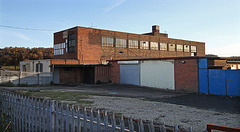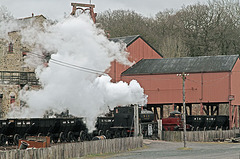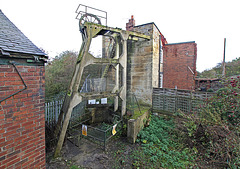
Coal Mining
Kellingley Colliery
| |
|
|
The recent announcement by UK Coal that its deep mining operations are financially unviable means that Kellingley Colliery is doomed to closure within the next 18 months. The 'Big K' still has extensive reserves but there will be no more development after the current new face has been completed.
Silverdale Colliery
| |
|
|
|
Silverdale Colliery was first sunk in the 1830s and went on to be the last deep mine operating in North Staffordshire when the final coal was worked here in December 1998. This is the No.17 shaft which was 1019 feet deep. There were four shafts numbered 14, 15 16 & 17 and four surface drifts in the 1980s.
Shady Oak Pit
| |
|
It may not look much now, but 180 years ago this was one of the main coal pits at work in Poynton. The Shady Oak Pit was sunk after 1826 and wound coal until the late 1830s. When I was a youngster I spoke with a former collier who was born in 1892. He had discussed this pit with old people in his youth and was able to relay to me the tale one of them told him of starting their career in mining by being sent down this pit at the age of 8 years to tend the air doors underground. What a life, having to sit alone in the dark for hours waiting to open the door as the coal tubs reached it. Not the good old days at all.
Kilnhurst Colliery
| |
|
|
The almost total destruction of the South Yorkshire coal industry means that the physical remains of the pits are rapidly disappearing. Kilnhurst Colliery, formerly known as either Thrybergh or Thrybergh Hall Colliery, was situated on the southern side of the village of Kilnhurst, near Rotherham, The pit was merged into the South Manvers complex in the 1950s and coal winding then ceased, with the No.4 shaft then used for men and materials. The colliery closed in 1988 and now only a few surface buildings survive in industrial use.
Fan housing
| |
|
The casing for the Walker Brothers fan dominates the scene outside the upcast winding enginehouse at Sutton Manor Colliery. The fan was 25 ft diameter and 9 ft wide and dated from 1910. It had a capacity of 600.000 cu ft per minute and was only on standby in the later years of the colliery. During the annual shutdown in 1985 it was run whilst maintenance work was carried out to the main ventilating plant. This was the last occasion that a steam driven fan operated at a British colliery.
Health & safety
| |
|
|
|
This enamel notice specifying minimum safety standards at the Quarry Pit of Poynton Collieries dates from the 1890s. At that time this particular pit was working a localised two foot thick seam of coal. Production ended at Quarry Pit in 1907.
The heritage business
| |
|
|
|
There is a trend towards commemorating collieries by siting a sheave, or often only half a sheave, at the site entrance or on a nearby roundabout. At Pooley Hall Colliery you are presented with the 'Rainbow Sheave of Heritage' which is obviously a most appropriate feature, or maybe not ............
The site is now a country park although the baths and workshop buildings remain in industrial use.
Engine House Cottage
| |
|
|
|
This former Newcomen enginehouse close to the blast furnace at Moira has been dated to 1805 based on a dated beam within. It pumped the Furnace Pit before conversion to housing in the nineteenth century. It is listed Grade II.
Pithead baths
The high tip
| |
|
|
|
Colourful lighting at sunset as a spoil train climbs the high tip at Sandaoling opencast coal mine.
Califat Colliery
| |
|
|
The mines on Swannington Common operated in the 18th and 19th century on a small scale, and Califat Colliery was one of these. The local heritage trust have undertaken excavations of the remains and also erected a replica horse gin and headframe with the horse and driver seen here. It is all very well done and the area is well worth a visit.
For use in emergency
| |
|
|
Self-rescuers in the lamp room at Snibston Colliery. For the uninitiated, these are used to provide an oxygen supply in an emergency when the mine atmosphere becomes unbreathable. Hopefully you could find fresh air in the time (up to an hour) that one of these would work. Not pleasant to use, but could save your life.
Power house
| |
|
|
Butterworth Hall Colliery was one of the largest in Milnrow in the early twentieth century. In 1869 the mine was owned by Richard and William Stott, but it was sold to Platt Brothers of Oldham. It is said to have been a very wet mine and it finally closed in 1928 after the workings became flooded. It was then purchased by Oldham Corporation for use as an underground reservoir, with upwards of a million gallons of water per day being pumped to Piethorne Reservoir, around 2 miles away. The headstocks were demolished in 1950.
This building was originally constructed as the power house for generating electricity for use on the colliery. It is now used by a civil engineering company.
The name lives on and today the shaft, which is situated a short distance behind this building continues to supply water, although the site is now run by United Utilities.
Hollin Busk Colliery
| |
|
|
|
The Hollin Busk Colliery, Stocksbridge, South Yorkshire, appears to have worked coal and fireclay (or possibly ganister). It is supposed to have reached Coal at 108ft and Pot Clay at 261ft. Until recently there were remains of a hand winch adjacent to the headgear. The winding shaft for the colliery was a short distance to the north west of this one which appears to have been sunk c1900 for ventilation. The whole mine had closed before 1930.
Caravans and Colliery
| |
|
|
|
Situated 1km south west of Ruabon, and in the middle of a caravan business, is this vertical winding engine house, built 1855-6 as one of the original structures of the Wynnstay Colliery. It is listed Grade II* as an exceptionally good example of the building type which is said to be the oldest surviving architectural monument in the North Wales Coalfield. It is also a Scheduled Ancient Monument.
Miners' Institute
| |
|
|
Ifton Colliery Miners' Institute at St Martin's was built in 1932 and remains open even though the pit has long gone.
Beamish Colliery screens
Hemingfield Colliery
| |
|
|
Hemingfield or Elsecar Low Colliery was sunk circa 1842-3 for Earl Fitzwilliam to work the Barnsley Bed Coal Seam at a depth of about 117 yards. By 1846 production had reached some 1000 tons per day.
After the mine finally closed for winding coal in 1920 one of the shafts continued to be used as a water pumping station. Since then the original headgears have been replaced by concrete structures and the Cornish engine house has been converted to a dwelling.
Jump to top
RSS feed- Latest items - Subscribe to the latest items added to this album
- ipernity © 2007-2025
- Help & Contact
|
Club news
|
About ipernity
|
History |
ipernity Club & Prices |
Guide of good conduct
Donate | Group guidelines | Privacy policy | Terms of use | Statutes | In memoria -
Facebook
Twitter


















